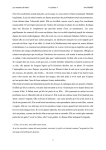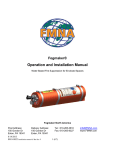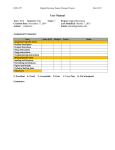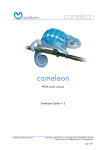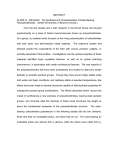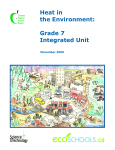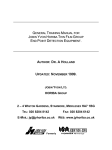Download Example 1
Transcript
ECE 477 Digital Systems Senior Design Project Rev 9/12 Ethical and Environmental Analysis Year: 2014 Semester: Fall Team: 03 Creation Date: November 13, 2014 Author: <redacted> Project: Real Time Vehicle Telemetry Last Modified: October 7, 2015 Email: [email protected] Assignment Evaluation: Item Assignment-Specific Items Environmental Impact Ethical Challenges Writing-Specific Items Spelling and Grammar Formatting and Citations Figures and Graphs Technical Writing Style Total Score 5: Excellent 4: Good Comments: Score (0-5) Weight Points 3: Acceptable 2: Poor Notes 1: Very Poor 0: Not attempted ECE 477 Digital Systems Senior Design Project Rev 9/12 1.0 Environmental Impact Analysis Although the RTVT system seems fairly safe for the environment, there are a few key areas related to manufacturing and end-of-life processes that may cause concern. The RTVT is constructed entirely from materials and components that no one would consider particularly exotic. All of the components inside the RTVT system are readily available for consumer purchase and are widely used in other electronic devices. Despite this fact, some materials used in the production of the RTVT system could have a negative impact on the environment during manufacturing and when the device is nearing the end of its lifecycle. Manufacturing processes used to create printed circuit boards require potentially dangerous chemicals that must be handled appropriately. Additionally, many components in the RTVT system are difficult to recycle or do not biodegrade. Special care must be taken to ensure that components at the end of their lifecycle do as little harm to the environment as possible. Nearly every system-level piece of consumer electronics these days makes use of tiny, surface mount electrical components attached to a printed circuit board. These boards make it possible to decrease the size of these products by a large factor, due to the tight tolerances and precise methods used to create the congested and complicated layouts. Although use of these products have skyrocketed as parts get smaller and designs get more complicated, there are environmental downsides to the manufacturing processes used to create printed circuit boards. Printed circuit boards (PCBs) are generally developed through a process that starts with a piece of laminate epoxy plated with a thin layer of copper on either side. PCB manufacturers then use a mask to expose only where traces will appear on the board, and use an additive process to increase the amount of copper present in these areas. The traces are plated with a different metal to act as a chemically resistant mask. Finally, the entire board is chemically etched to remove the excess copper, and as a result, only plated copper traces remain on the surface. The problem with this process is that chemical etchers used in the subtractive process are potentially dangerous for the environment. Etching is typically done using ammonium persulfate or ferric chloride. These chemicals, especially ferric chloride, are potentially dangerous to humans and animals due to their toxicity and acidity. The material safety data sheet (MSDS) for ferric chloride [1] states that ferric chloride is “very dangerous in case of ingestion.” The data sheet also states that the HMIS health classification of ferric chloride is a 3, which falls into the category of “serious hazard [2]”. In addition to the health hazards of ferric chloride, these etching chemicals also become saturated with copper as the etching process prolongs. The etching reaction produces copper chloride, as iron in the ferrous chloride solution is replaced with copper from the board. Copper chloride is possibly even more dangerous than ferric chloride. The MSDS for copper chloride states that the solution is “very toxic to aquatic organisms” and that it “may cause long-term adverse effects in the aquatic environment [3].” In addition to potentially harmful chemicals used in the PCB manufacturing process, certain materials used in the RTVT system could cause environmental issues when the RTVT system reaches the end of its life. In its packaged, manufactured state, the RTVT system does not pose much of a threat to the environment in terms of harmful chemicals or hazardous materials. -1- ECE 477 Digital Systems Senior Design Project Rev 9/12 Instead, portions of the RTVT system cannot be easily disposed of or recycled, and may contribute to increasing landfill sizes and decreasing availability of rare materials. Many electronic components, especially high quality and precision pieces of equipment, rely on uncommon earth metals for their useful electrical and thermal characteristics. Metals and semiconductor materials like gold, silver, tantalum and palladium appear frequently in electronic equipment. These materials are in limited supply and have succumbed to shortages in the past when demand for these materials grew too high. Sources have shown that rare metals like tantalum can only be extracted for another fifty years before our natural supply runs out [4]. Materials with multiple purposes outside of electronics, such as gold and silver, are not exactly in abundant supply, either. Electronic components use gold frequently as a high quality connector surface, immune to oxidation and thermal disadvantages plagued by other materials. With a limited natural supply of these materials, it is imperative that some initiative be taken to reduce the amount of rare earth metals in consumer electronics being thrown into landfills. While rare earth metals are highly regarded for their usefulness, other materials are notorious for their practicality, but nonexistent biodegradability. Plastic components in particular are noteworthy in that they are extremely flexible in modern manufacturing processes. Plastics can be molded and formed into nearly any shape required and are cheaper than almost any other material for producing component packaging. With the advent of 3D printing laboratories, prototyping runs and small scale processes can produce complex parts without the need for a full machine shop and expensive raw materials. While plastics are incredibly for their flexibility in manufacturing, they are notoriously non-biodegradable. When products reach the end of their life, there is little consumers can do to break down these plastic packaging components, and must resort to sending them to landfills. Burning plastics also releases dangerous gasses called dioxins that can cause human respiratory disease, and many states specifically have regulations on dioxin emissions that are released when these plastics are burned [5]. There is little that can be done with regards to breaking down these materials without harming the environment. It is apparent that some action must be taken to combat the adverse effects of both chemical processes in manufacturing and the breakdown of end-of-life electronic components. The RTVT system is not unlike many other electronic components: it is dependent on PCB manufacturing for a compact mounting and routing system; components on the board may use trace amounts of rare earth metals commonly found in electronic systems; and the packaging of the RTVT system uses 3D printed plastic in its entirety. To combat these adverse effects, the RTVT system design and manufacturing process could be changed in a few ways. First of all, to reduce the environmental impact of its manufacturing processes, the RTVT system should be produced only in fabrication houses that enforce a strict, environment-friendly approach to chemical waste management. Many of these waste materials have government regulations regarding how the material should be handled and properly disposed of. It is important that the RTVT system’s PCB be produced in a fabrication house that is cognizant with these regulations and enforces them strictly. The risk for environmental contamination with PCB production materials is limited mostly to small scale, homebrew electronics production, where hobbyists have a tendency to wash hazardous materials down the drain unknowingly or out of laziness. It is much more likely that an established fabrication house is aware of these -2- ECE 477 Digital Systems Senior Design Project Rev 9/12 regulations and abides by them, so it is in our best interest to continue development with larger, more prominent fabrication houses. Secondly, the RTVT system also uses a number of components that are manufactured by other companies on separate PCBs. To ensure that manufacturing processes of these individual components are not affecting the environment would require insider information into the manufacturing processes of the companies that develop the products. In the case that the RTVT becomes a large-volume product, the environmental interests of our suppliers would definitely be taken into account when choosing a component supply chain. Thirdly, steps could be taken to reduce the RTVT system’s reliance on rare earth metals for low tolerance capacitors and high quality components. Generally, these rare metals are used to meet high performance specifications. In the prototype phase, unnecessarily high quality parts are purchased to ensure that the product can be functional, as a sort of proof of concept. In certain situations, it is simply not necessary to have a very precise part when its less precise counterpart will function perfectly in every scenario. Analysis could be done on each part in the consumer version of the RTVT system to ensure that the most environmental-friendly parts are being used, without sacrificing core functionality of our system as a whole. In addition, the components used in our supplier’s parts are widely unknown, especially in large scale systems such as the GPS and Bluetooth devices. It would be imperative to investigate the materials used in creating these components, and ensure that each part only uses materials absolutely required to meet the specification that we need. Lastly, the manufacturing process for the packaging of the RTVT system could be evaluated to ensure that the thickness and quality of plastic products used in prototypical development stages are actually required for mass production. Reducing the quantity of 3D printed plastics in our device would reduce the amount of non-biodegradable material being sent to landfills. It may even be the case the biodegradable materials be used instead for packaging the RTVT device. Once the lifetime of the product is known, a lifetime could be calculated for the packaging, allowing specific biodegradable materials to be used when constructing the RTVT system. 2.0 Ethical Challenges During production of a new part, it is common to come across issues that could cause software crashes of the device, hardware failures, and even stress failures or situations that could cause physical harm to human beings. Engineers strive to make their products as useful and userfriendly as possible, while reducing the risk of harm to the consumer or others. Many products have components that can cause physical harm to their consumers in the most extreme situations. Instead of ignoring these situations and hoping that a warning was not necessary, it is in the best interest of companies to print warning labels and provide cautionary advice in documentation when dealing with these somewhat implausible situations. Not unlike nearly any electronic component on the market today, the RTVT also has its share of risks that must be accounted for. Although they are extremely unlikely to occur, it is in our best interest to ensure that the consumer knows as much about the product as possible, and that they are prepared to deal with potentially harmful situations. -3- ECE 477 Digital Systems Senior Design Project Rev 9/12 The RTVT system is relatively risk-free overall, considering that it does not deal with volatile materials or moving parts, and is not in control of electronic or mechanical systems that are considered life-threatening or potentially harmful to a consumer. That being said, special care must be taken such that the consumer knows that certain reckless interactions with our device could cause them physical harm. Our device is intended to be used as a dashboard mounted device inside a motor vehicle. Operators of these vehicles must remain completely focused and attentive on the road, aware of possible hazards and ready to avoid any possible collisions with other automobiles or pedestrians. The RTVT system could potentially impair drivers in this regard, as a driver may want to change settings on the device while the vehicle is in motion. Their attention then is no longer on the road and the risk of bodily harm rises tremendously. Additionally, it is imperative that the RTVT system remain motionless on the dashboard while the vehicle is moving. If the RTVT system has a tendency to fall off the dashboard or move around while the vehicle is in motion, users could be in danger if they decide to remount the device while maneuvering the vehicle. Under normal operation conditions, the RTVT system pulls such small amounts of power that directly interacting with the power mains for the device would not cause the user any bodily harm. However, in certain environments, situations may arise that endanger the user when handling the device. Although it is very unlikely, the power cord connecting to the RTVT system could be shorted due to a failure within the device itself and demand a large amount of current through the shorted wire. Situations such as these can cause wires to heat up tremendously, and users could be harmed by components hot to the touch due to power failures on the device. Even more unlikely is that the consumer decides to take the product apart. It is possible that the power supply for the device create a fair amount of heat when regulating the voltage from five volts down to 3.3 volts. Though implausible, this is a situation we stand to create for the consumer when releasing a product to them. To ensure that customers are as safe as possible when using the RTVT system, it is important that notices be placed on the packaging of the device clearly stating that bodily harm could be caused by misuse of certain elements of the product. First and foremost, the RTVT system should not compete for the driver’s attention while the driver is attempting to maneuver the vehicle. Many states in the United States do not allow windshield mounted GPS units because they obstruct the field of view of the driver [6]. Even though the RTVT is not windshield mounted, it is important that we ensure that the operator does not obstruct their vision by placing the RTVT system in a poor location, and that the RTVT system will never require attention from the driver. To accomplish this, the consumer version of the RTVT system will have a feature that locks touchscreen menus from access while the vehicle is in motion. This prevents the user from trying to navigate the menus while they should be paying attention to the road. Additionally, it may be necessary to print recommended mounting locations for different vehicle types in the user manual so that users do not accidentally mount their device in a location that could impair their vision. In addition to possible vision impairment, electrical failures of the RTVT system could cause components on the device to become hot to the touch, especially if users have dismantled the product for some reason. It would only be ethical to prominently display a warning label on the -4- ECE 477 Digital Systems Senior Design Project Rev 9/12 device or in user documentation explaining that dismantling the device could cause the user physical harm through burns and possibly electric shock. Apart from risks to the user’s physical condition, the RTVT system also has the capability of corrupting user data on SD card formats. When the user inserts an SD card into the system, they entrust the RTVT to maintain any data the user stored previously on the card while storing new information relevant to the task at hand. In the case that the SD card file system libraries fail on the RTVT system, pictures and documents that may have been stored on the SD card could easily be corrupted. To ensure that users are aware of the risk of inserting SD media formats into the RTVT system, a warning should clearly be placed in the user documentation or on the device itself. Many users may decide to use a dedicated SD card for the RTVT system, eliminating the risk of losing valuable personal files. In conclusion, many considerations must be made for the RTVT system as it moves toward consumer markets. Mass production of parts, while cost effective and consistent, has the capability of producing large amounts of hazardous waste and non-biodegradable materials. To combat this, analysis must be performed on the part itself to ensure that every rare metal and environmentally unfriendly material used is absolutely necessary for the part to function correctly. By limiting PCB production to fab houses that comply with environmental regulations, we can ensure that the RTVT system’s manufacturing processes are not harming wildlife. Additionally, the RTVT system’s documentation must be carefully constructed to make sure that users do not find themselves in potentially harmful situations without being adequately warned. Steps can even be taken to ensure that consumers cannot interact with the device when it is unsafe to do so. By altering manufacturing processes, material selection, and user documentation, the RTVT system is capable of being an environmentally friendly, resourceful part that is safe for all consumers to handle. 3.0 Sources Cited [1] [2] [3] [4] [5] [6] Science Lab. (05/21/2013). Material Safety Data Sheet: Ferric chloride MSDS [Online]. Available: http://www.sciencelab.com/msds.php?msdsId=9924033 American Coatings Association. HMIS III – Hazardous Materials Identification System [Online]. Available: http://www.paint.org/programs/hmis.html Acros Organics. (8/23/2007). Material Safety Data Sheet – Copper(II) chloride, anhydrous [Online]. Available: http://www.ch.ntu.edu.tw/~genchem99/msds/exp22/CuCl2.pdf Ecclestone, Christopher. (9/30/2014). The eternal temptation of tantalum, Alkane and MDN lead the pack [Online]. Available: http://investorintel.com/rare-earthintel/tantalum-eternal-tempting/ Environmental Protection Agency. (11/15/2013). Outdoor Air – Industry, Business, and Home: Backyard Trash Burning [Online]. Available: http://www.epa.gov/oaqps001/community/details/barrelburn_addl_info.html Alkhalikoi, Strephon. (9/25/2011). Laws – Windshield Law and the GPS Receiver [Online]. Available: http://www.poi-factory.com/node/34521 -5-







